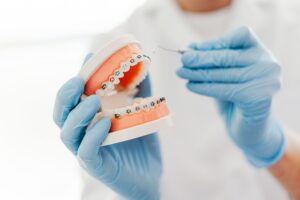 Orthodontics can significantly enhance a person’s smile by straightening crooked teeth, closing gaps, and aligning the overall bite. These corrections can also help reduce the risk of oral health issues such as tooth decay, gum disease, and jaw pain, which can arise from improper teeth alignment.
Orthodontics can significantly enhance a person’s smile by straightening crooked teeth, closing gaps, and aligning the overall bite. These corrections can also help reduce the risk of oral health issues such as tooth decay, gum disease, and jaw pain, which can arise from improper teeth alignment.
While many are familiar with the premise of this branch of dentistry, there are plenty of myths about orthodontics that may prevent potential patients from pursuing the treatment that they need. At Murphy Orthodontics, board-certified orthodontist Chris Murphy, DDS, MS is dedicated to helping patients feel confident in their chosen treatment. His vast experience makes him thoroughly qualified to debunk common myths and provide further information about available options.
Here are seven misconceptions about orthodontic treatment:
1. Metal braces are the only teeth straightening option.
Traditional metal braces have long been the go-to approach for straightening teeth. While braces are still an effective option for some patients, others may benefit more from Invisalign® treatment. As a popular alternative to metal braces, Invisalign® gradually shifts teeth into a better and more aesthetically pleasing position. Treatment involves the use of clear, removable, and custom aligners, which are less conspicuous than metal wires and brackets.
2. Braces are only helpful to improve smile appearances.
While one of the top benefits of braces is that the treatment can improve the aesthetic appearance of one’s smile, this orthodontic solution also offers functional enhancements. When tooth and jaw misalignment are corrected, it makes it easier to chew, bite, and speak. Additionally, straighter teeth offer fewer areas where food can get stuck, and they make it easier to brush and floss. These benefits can help improve overall oral health.
3. Orthodontic treatment is painful.
It has often been thought that all orthodontic treatments are painful. Even though there may be minor discomfort at the beginning of treatment as teeth begin to shift, advancements in techniques have created more comfortable experiences for many patients.
4. Straightening teeth takes a long time.
The length of orthodontic treatment will vary from patient to patient, with the timeline often influenced by the specific concerns being addressed. More severe orthodontic issues may require longer treatment time. In most cases, Invisalign® treatment can take 6 to 15 months, while braces may take 6 months to 2 years for optimal outcomes.
5. Orthodontic treatment is only for kids and teens.
While braces and orthodontic treatments are commonly associated with children and younger patients, individuals of all ages struggle with dental concerns such as unwanted smile gaps, bite irregularities, and teeth misalignment. Orthodontic techniques can also benefit adults and improve their oral health, jaw function, and satisfaction with their smile.
6. Once my braces are removed, there is nothing else I must do.
Some patients believe that once their braces are removed, their teeth will remain straight forever and there is nothing else they need to do. This is typically not the case. Oftentimes, patients will receive a retainer to wear, making it an important part of orthodontic treatment. Retainers help your teeth remain in the desired position, and neglecting to wear your retainer can lead to teeth shifting back, thus requiring additional treatment.
7. Orthodontic treatment is always expensive.
A common misconception is that orthodontic treatment is always expensive. While oral health can be an investment, treatment plans are customized to reflect your specific needs and goals. This means that treatment cost often varies. Additionally, at Murphy Orthodontics, we offer financing options that help make payments easier to manage and budget for. We have partnered with third-party lenders CareCredit® and LendingClub® to help make treatments including Invisalign® and braces more accessible for qualified applicants. Depending on your insurance plan, some level of treatment coverage may be available. Prior to your first appointment, we can help you determine what your insurance covers.
For more information about orthodontic treatment, or to schedule a consultation with Dr. Murphy, contact our office today.
Previous Post Next Post